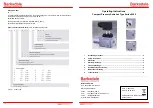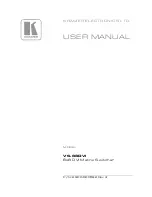
25
4.3.4B Terminal Server (continued)
Server Type:
In most cases the iServer will be acting as a Slave device.
Slave
option is
chosen when a network host needs to connect to the serial port of the iServer (default is
Slave
). With RS485 connection, the
Host
option is selected if the connection is initiated
from the serial device targeting a node on the network.
Number of Connections:
The range is from
0
to
5
.
If
0
is selected, the Terminal Server feature is disabled. This means that no network
connection can be made to the serial port of the iServer.
If
1
is selected, only one network connection can be made to the iServer’s serial port.
Any number more than 1 would allow the network hosts to monitor (read only) the traffic
on the iServer’s serial port simultaneously, but only one network host would be allowed
to read and write (default is
5
).
Local Port:
This is the port or socket number for the iServer’s serial port. Any number
between
500
and
9999
can be defined with the exceptions of
1000
and
2002
which are
already used by the iServer for other purposes (default is
2000
.)
Port number
502
is the default socket number for Modbus/TCP protocol. If Modbus/TCP
is enabled in the iServer, it’s then suggested to use
502
for the Local Port unless your
host software that supports Modbus/TCP indicates otherwise.
If your application software is IP enabled, it means that it can open a connection
to a node on the network (i.e. iServer with the attached serial device) with an IP
address and a port number.
In some cases the application software may not allow you to specify the iServer’s
port number (it only allows you to enter the iServer’s IP address). In these cases,
you should put
23
in the Local Port field of the iServer. By doing this, the iServer
will forward connections that are made to its Ethernet port directly to its serial port.
Connection Control:
Some serial devices accept connections or disconnect
connections based on certain signal conditions.
For example: a serial device may accept a connection only if the incoming DTR signal
(connected to device’s DSR or DCD) is high or low. In this case, when the iServer
receives the TCP connection, before it forwards it to its serial port, it must raise its DTR
(DTR+) or to lower its DTR (DTR-). The iServer is capable of doing this with any of the
hardware or modem control signals (DTR, DSR, DCD, RTS, and CTS).
"Reconnect" is one of the options in the Connection Control menu. This option
can be used in the Serial Tunneling described in
Section 4.11
. If the connection
in Serial Tunneling is broken due to network problems, power failure, etc., the
Reconnect option will try to get the connection back on line every whatever the
"Connection Timeout" is set to.
For example: if the Connection Timeout is set to 1000 x10 ms or 10 seconds,
then every 10 seconds the iServer attempts to reconnect and reestablish the
serial tunnel to the other network node.
Device No.:
Refer to
Section 4.3.1
4.3.4.C Remote Access (Tunneling)
Remote Access:
This option needs to be
enabled
when Serial Tunneling is configured.
The Serial Tunneling is explained in detail in
Section 4.11
.
Changes made in the iServer’s Configuration page can be saved permanently
by pressing the
Save button
.
Pressing the
Reset button
will set all the fields back to their default values.
















































